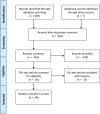Systematic review of Kinect applications in elderly care and stroke rehabilitation
- PMID: 24996956
- PMCID: PMC4094409
- DOI: 10.1186/1743-0003-11-108
Systematic review of Kinect applications in elderly care and stroke rehabilitation
Abstract
In this paper we present a review of the most current avenues of research into Kinect-based elderly care and stroke rehabilitation systems to provide an overview of the state of the art, limitations, and issues of concern as well as suggestions for future work in this direction. The central purpose of this review was to collect all relevant study information into one place in order to support and guide current research as well as inform researchers planning to embark on similar studies or applications. The paper is structured into three main sections, each one presenting a review of the literature for a specific topic. Elderly Care section is comprised of two subsections: Fall detection and Fall risk reduction. Stroke Rehabilitation section contains studies grouped under Evaluation of Kinect's spatial accuracy, and Kinect-based rehabilitation methods. The third section, Serious and exercise games, contains studies that are indirectly related to the first two sections and present a complete system for elderly care or stroke rehabilitation in a Kinect-based game format. Each of the three main sections conclude with a discussion of limitations of Kinect in its respective applications. The paper concludes with overall remarks regarding use of Kinect in elderly care and stroke rehabilitation applications and suggestions for future work. A concise summary with significant findings and subject demographics (when applicable) of each study included in the review is also provided in table format.
Figures


Similar articles
-
Falls prevention interventions for community-dwelling older adults: systematic review and meta-analysis of benefits, harms, and patient values and preferences.Syst Rev. 2024 Nov 26;13(1):289. doi: 10.1186/s13643-024-02681-3. Syst Rev. 2024. PMID: 39593159 Free PMC article.
-
Interventions for improving upper limb function after stroke.Cochrane Database Syst Rev. 2014 Nov 12;2014(11):CD010820. doi: 10.1002/14651858.CD010820.pub2. Cochrane Database Syst Rev. 2014. PMID: 25387001 Free PMC article.
-
Exercise rehabilitation following intensive care unit discharge for recovery from critical illness.Cochrane Database Syst Rev. 2015 Jun 22;2015(6):CD008632. doi: 10.1002/14651858.CD008632.pub2. Cochrane Database Syst Rev. 2015. PMID: 26098746 Free PMC article.
-
Pain management for women in labour: an overview of systematic reviews.Cochrane Database Syst Rev. 2012 Mar 14;2012(3):CD009234. doi: 10.1002/14651858.CD009234.pub2. Cochrane Database Syst Rev. 2012. PMID: 22419342 Free PMC article.
-
Yoga for stroke rehabilitation.Cochrane Database Syst Rev. 2017 Dec 8;12(12):CD011483. doi: 10.1002/14651858.CD011483.pub2. Cochrane Database Syst Rev. 2017. PMID: 29220541 Free PMC article.
Cited by
-
Virtual reality experiences, embodiment, videogames and their dimensions in neurorehabilitation.J Neuroeng Rehabil. 2018 Nov 26;15(1):113. doi: 10.1186/s12984-018-0461-0. J Neuroeng Rehabil. 2018. PMID: 30477527 Free PMC article.
-
Quantitative Comparison of Hand Kinematics Measured with a Markerless Commercial Head-Mounted Display and a Marker-Based Motion Capture System in Stroke Survivors.Sensors (Basel). 2023 Sep 15;23(18):7906. doi: 10.3390/s23187906. Sensors (Basel). 2023. PMID: 37765963 Free PMC article.
-
Virtual rehabilitation: What are the practical barriers for home-based research?Digit Health. 2016 Apr 29;2:2055207616641302. doi: 10.1177/2055207616641302. eCollection 2016 Jan-Dec. Digit Health. 2016. PMID: 29942551 Free PMC article.
-
Virtual reality for stroke rehabilitation.Cochrane Database Syst Rev. 2025 Jun 20;6(6):CD008349. doi: 10.1002/14651858.CD008349.pub5. Cochrane Database Syst Rev. 2025. PMID: 40537150 Free PMC article.
-
Feasibility of Using Low-Cost Motion Capture for Automated Screening of Shoulder Motion Limitation after Breast Cancer Surgery.PLoS One. 2015 Jun 15;10(6):e0128809. doi: 10.1371/journal.pone.0128809. eCollection 2015. PLoS One. 2015. PMID: 26076031 Free PMC article.
References
-
- Tanaka K, Parker J, Baradoy G, Sheehan D, Holash JR, Katz L. A comparison of exergaming interfaces for use in rehabilitation programs and research. Loading. 2012;6(9):69–81.
-
- World Health Organization. International Classification of Functioning, Disability and Health (ICF) Geneva: WHO; 2002.
-
- Berg K, Wood-Dauphinee S, Williams J. The Balance Scale: reliability assessment with elderly residents and patients with an acute stroke. Scand J Rehabil Med. 1995;27:27–36. - PubMed
-
- Tinetti ME. Performance-oriented assessment of mobility problems in elderly patients. J Am Geriatr Soc. 1986;34(2):119–126. - PubMed
Publication types
MeSH terms
LinkOut - more resources
Full Text Sources
Other Literature Sources
Medical

